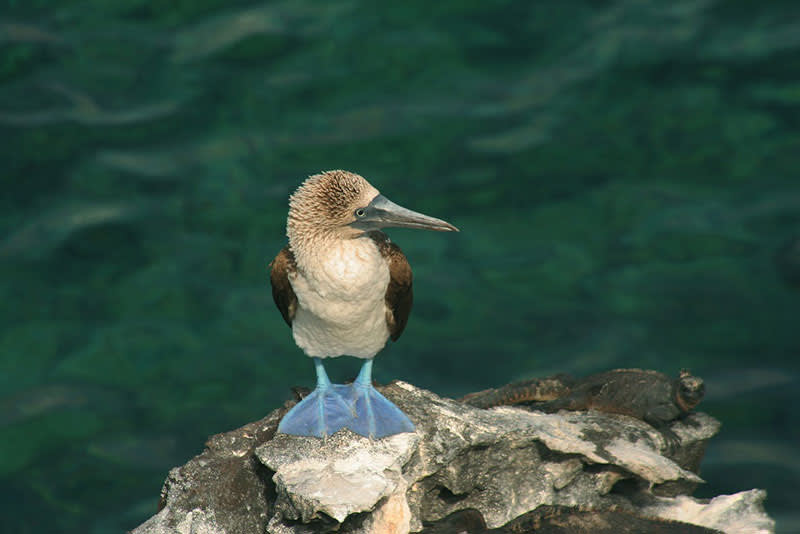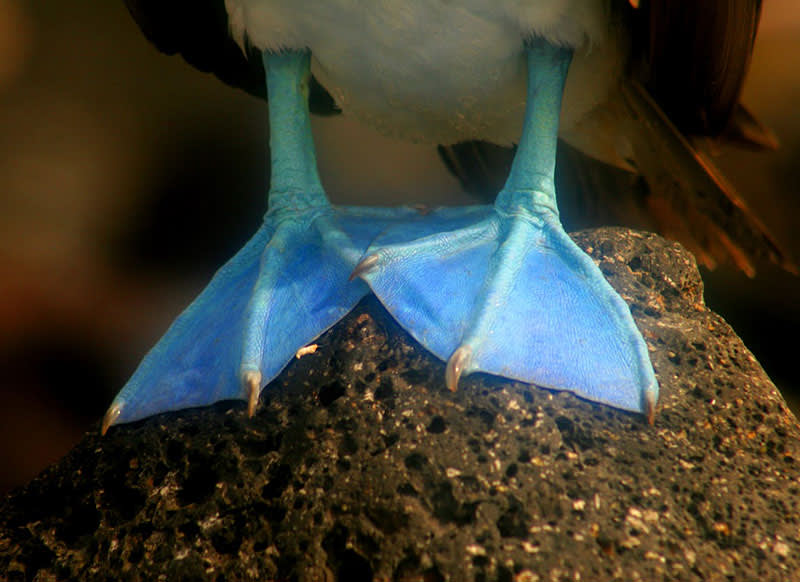The Galapagos Islands offer voyagers many exclusive, once in a lifetime opportunities. A large part of the intrigue and enchantment of the Islands is its rare wildlife species — from tortoises to penguins — many of which have been, or are in danger of becoming, extinct. Still, the delightful blue-footed booby, with its indigo feet and cheerful-sounding name, might be the most popular and well known inhabitant of the islands.

Photo Credit: Ecuador’s Ministry of Tourism
While there are opportunities to see this bird off the coasts of Central and South America, a large number of breeding pairs are found in the Galapagos. The blue-footed booby is yet another of the many natural beauties you’ll encounter on your Galapagos cruise.
Blue-footed Booby More Talented than Its Name Implies
While discussing the blue-footed booby involves the fun of saying booby over and over, it is named so because of the Spanish word “bubi”, or “bobo”, meaning “stupid fellow” or just “stupid.” Seabirds in general are often considered to be unwitting (it isn’t unusual for boobies to trust visitors and voluntarily jump and land into dangerous situations), and the booby also appears quite clumsy on land.
This state of awkwardness is mostly because their best work and most graceful acts take place in the air, while searching the water below for sardines, anchovies, flying fish, and even squid, and then skillfully diving to dine. Furthermore, boobies are especially talented at diving from a sitting position on the water itself.
Pretty Turquoise Feet with a Purpose
Although it isn’t clear why nature blessed the booby with its stunning, brightly colored feet, we do know that both male and female birds use their feet for covering the baby boobies to keep them warm.
Their blue feet are also an important part of the boobies’ reproductive strategy. Because their foot color dulls as they age, to select males who are the youngest, most fertile and most capable of caring and providing for the chicks, female boobies select and mate with males sporting the brightest feet.
Like many species, the male booby works to impress and attract his mate by performing an elaborate dance. These smooth moves involve raising one of his blue feet into the air, stamping it on the ground, and then raising the other in the air and stamping it down. All while strutting before the prospective mate as if to say, “check out these feet.”
This complicated ritual also involves pointing his head and bill upward with his wings and tail raised, and presenting his potential mate with twigs and stones for building a nest, even though boobies generally nest on bare ground.

Photo Credit: Ecuador’s Ministry of Tourism
Survival on the Galapagos Islands
Despite elaborate mating rituals, and the Galapagos Islands being home to the majority of the world’s breeding pairs, the blue-footed booby population is declining. The population has dropped from 20,000 in the 1960s to only about 6,400 today.
The Decline of Blue-footed Booby Populations
Causes could be the decline in clupeid fish and sardines, which are a staple of the boobies’ diet. Another reason for the decline may be breeding problems. Although adult birds experience typical mortality rates, the population is not replenishing from new young adult birds – meaning younger generations may not be performing their high-kicking enough.
Research and preservation of the blue-footed booby are critical efforts in the Galapagos Islands, not only because of the need to protect the precious birds, but because the boobies play a large part in balancing the entire ecosystem. A scarcity of chicks also places hawks that feed on them at risk. Boobies have also begun to spend less time inland and more of their time on rocks and cliffs, presumably hunting for food, making their guano unavailable for soil enrichment.
If you’d like to see blue-footed boobies in the wild, take a look at our new Galapagos Islands expeditions.








